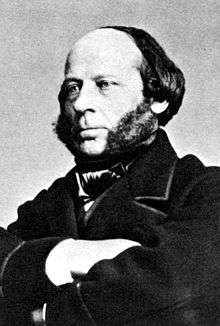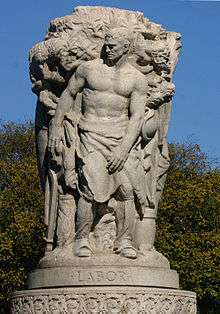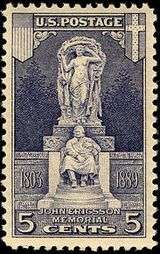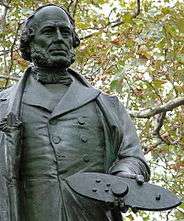John Ericsson
| John Ericsson | |
|---|---|
 | |
| Born |
July 31, 1803 Långbanshyttan, Värmland |
| Died |
March 8, 1889 (aged 85) New York |
| Occupation | Engineer, innovator |
| Signature | |
|
| |
John Ericsson (born Johan) (July 31, 1803 – March 8, 1889) was a Swedish-American inventor, active in England and the United States, and regarded as one of the most influential mechanical engineers ever. Ericsson collaborated on the design of the steam locomotive Novelty, which competed in the Rainhill Trials on the Liverpool and Manchester Railway, won by George Stephenson's Rocket. In America he designed the US Navy's first screw-propelled steam-frigate USS Princeton, in partnership with Captain Robert Stockton, who unjustly blamed him for a fatal accident. A new partnership with Cornelius H. DeLamater of the DeLamater Iron Works in New York resulted in the first armoured ship with a rotating turret, the USS Monitor, which dramatically saved the US naval blockading squadron from destruction by an ironclad Confederate vessel, CSS Virginia, at Hampton Roads in March 1862.[1]
Early career

Johan Ericsson was born at Långban in Värmland, Sweden. He was the brother of Nils Ericson, a distinguished canal and railway builder in Sweden. Their father Olaf Ericsson (1778-1818) had worked as the supervisor for a mine in Värmland. He had lost money in speculation and had to move his family to Forsvik in 1810. There he worked as a director of blastings during the excavation of the Swedish Göta Canal.[2][3]
The extraordinary skills of the two Ericsson brothers were discovered by Baltzar von Platen, the architect of the Göta Canal. They were dubbed 'cadets of mechanics' of the Swedish Royal Navy, and engaged as trainees at the canal enterprise. At the age of fourteen, John was already working independently as a surveyor. His assistant had to carry a footstool for him to reach the instruments during surveying work. At the age of seventeen he joined the Swedish army in Jämtland, serving in the Jämtland Field Ranger Regiment, as a Second Lieutenant, but was soon promoted to Lieutenant. He was sent to northern Sweden to do surveying, and in his spare time he constructed a heat engine which used the fumes from the fire instead of steam as a propellant. His skill and interest in mechanics made him resign from the army and move to England in 1826. However his heat engine was not a success, as his prototype was designed to burn birchwood and would not work well with coal (the main fuel used in England).[4]

Notwithstanding the disappointment, he invented several other mechanisms instead based on steam, improving the heating process by adding fans to increase oxygen supply to the fire bed. In 1829 he and John Braithwaite built "Novelty" for the Rainhill Trials arranged by the Liverpool and Manchester Railway. It proved considerably faster than the other entrants but suffered recurring boiler problems, and the competition was won by English engineers George and Robert Stephenson with Rocket.
Two further engines were built by Braithwaite and Ericsson, named William IV and Queen Adelaide after the new king and queen. These were generally larger and more robust than Novelty and differed in several details (for example it is thought that a different design of blower was used which was an 'Induced Draught' type, sucking the gases from the fire). The pair ran trials on the Liverpool and Manchester Railway but the railway declined to purchase the new designs.
Their innovative steam fire engine proved an outstanding technical success by helping to quell the memorable Argyll Rooms fire[5] on February 5, 1830[6] (where it worked for five hours when the other engines were frozen up),[7] but was met with resistance from London's established 'Fire Laddies' and municipal authorities. An engine Ericsson constructed for Sir John Franklin's use failed under the Antarctic conditions for which, out of Franklin's desire to conceal his destination, it had not been designed. At this stage of Ercisson's career the most successful and enduring of his inventions was the steam condenser, which allowed a steamer to produce fresh water for its boilers while at sea. His 'deep sea lead,' a pressure-activated fathometer was another minor, but enduring success. The commercial failure and development costs of some of the machines devised and built by Ericsson during this period put him into debtors' prison for an interval. At this time he also married 19-year-old Amelia Byam, a disastrous match that ended in the couple's separation until Amelia's death.
Education
His only formal education was a basic officer's education and training during his time in the Swedish Army. On 27 March 1822, John passed a surveyor's examination in Stockholm. As a child he was taught to be a miner and surveyor by his father.[8]
Propeller design

He then improved ship design with two screw-propellers moving in different directions (as opposed to earlier tests with this technology, which used a single screw). However, the Admiralty disapproved of the invention, which led to the fortunate contact with the encouraging American captain Robert Stockton who had Ericsson design a propeller steamer for him and invited him to bring his invention to the United States of America, as it would supposedly be more welcomed in that place. As a result, Ericsson moved to New York in 1839. Stockton's plan was for Ericsson to oversee the development of a new class of frigate with Stockton using his considerable political connections to grease the wheels. Finally, after the succession to the Presidency by John Tyler, funds were allocated for a new design. Unfortunately they only received funding for a 700-ton sloop instead of a frigate. The sloop eventually became USS Princeton, named after Stockton's hometown.
The ship took about three years to complete and was perhaps the most advanced warship of its time. In addition to twin screw propellers, it was originally designed to mount a 12-inch muzzle-loading gun on a revolving pedestal. The gun had also been designed by Ericsson and used hoop construction to pre-tension the breech, adding to its strength and allowing safe use of a larger charge. Other innovations on the ship design included a collapsible funnel and an improved recoil system.
The relations between Ericsson and Stockton had grown tense over time and, approaching the completion of the ship, Stockton began working to force Ericsson out of the project. Stockton carefully avoided letting outsiders know that Ericsson was the primary inventor. Stockton attempted to claim as much credit for himself as possible, even designing a second 12 in (300 mm) gun to be mounted in Princeton. Unfortunately, not understanding the design of the first gun (originally named "The Orator", renamed "The Oregon" by Stockton), the second gun was fatally flawed.
When launched, Princeton was an enormous success. On October 20, 1843, she won a speed trial against the paddle steamer SS Great Western, until then considered the fastest steamer afloat. Unfortunately, during a firing demonstration of Stockton's gun, the breech ruptured, killing Secretary of State Abel P. Upshur and Secretary of the Navy Thomas Gilmer, as well as six others. Stockton attempted to deflect the blame onto Ericsson, with moderate success, despite the fact Ericsson's gun was sound and it was Stockton's gun that had failed. Stockton also refused to pay Ericsson, and by using his political connections, Stockton blocked the Navy from paying him. These actions led to Ericsson's later deep resentment toward the U.S. Navy.
Friendship with Cornelius H. DeLamater
When Ericsson arrived from England and settled in New York, he was persuaded by Samuel Risley of Greenwich Village to give his work to the Phoenix Foundry. There he met Cornelius H. DeLamater and soon a mutual attachment developed between the two, and rarely thereafter did Ericsson or DeLamater enter upon a business venture without first consulting the other."[9] Personally, their friendship never faltered, though strained by the pressures of business and Ericsson's quick temper, DeLamater called Ericsson "John" and Ericsson called DeLamater by his middle nickname "Harry", intimacies almost unknown in Ericsson's other relationships.[10] In time, the DeLamater Iron Works became known as the Asylum where Capt Ericsson had free rein to experiment and attempt new feats. The Iron Witch was next constructed, the first iron steamboat.[11] The first hot-air invention of Capt Ericsson was first introduced in the ship Ericsson, built entirely by DeLamater. The DeLamater Iron Works also launched the first submarine boat, first self-propelled torpedo, and first torpedo boat.[12] When DeLamater died on February 2, 1889, Ericsson could not be consoled. Ericsson's death one month later was not surprising to his close friends and acquaintances."[13]
Hot air engine
Ericsson then proceeded to invent independently the caloric, or hot air engine in the 1820s which used hot air, caloric in the scientific parlance of the day, instead of steam as a propellant. A similar device had been patented in 1816 by the Reverend Robert Stirling, whose technical priority of invention provides the usual term 'Stirling Engine' for the device. Ericsson's engine was not initially successful due to the differences in combustion temperatures between Swedish wood and British coal. In spite of his setbacks, Ericsson was awarded the Rumford Prize of the American Academy of Arts and Sciences in 1862 for his invention. In his later years, the caloric engine would render Ericsson comfortably wealthy, as its boilerless design made it a much safer and more practical means of power for small industry than steam engines. Ericsson's incorporation of a 'regenerator' heat sink for his engine made it tremendously fuel-efficient. Apparently in the post Civil War era some time before or around 1882, from the publishing date, a ship was purchased by a Captain Charles L. Dingley called the Ericsson with a weight of 1,645 tons that was built by John Ericsson (Although the above section on John Ericsson's Friendship with Cornelius H. DeLamater says that the ship known as the Ericsson was built by the DeLamater Iron Works) to try out the hot air engine as a motive power in open ocean navigation.[14]
Ship Design
On September 26, 1854, Ericsson presented Napoleon III of France with drawings of iron-clad armored battle ships with a dome-shaped gun tower, and even though the French emperor praised this particular plan of an invention, he did nothing to bring it to practical application. In 1851 he designed the Caloric ship Ericsson.

USS Monitor

Shortly after the American Civil War broke out in 1861, the Confederacy began constructing an ironclad ram upon the hull of USS Merrimack which had been partially burned and then sunken by Federal troops before it was captured by forces loyal to the Commonwealth of Virginia. Nearly concurrently, the United States Congress had recommended in August 1861 that armored ships be built for the American Navy. Ericsson still had a dislike for the U.S. Navy, but he was nevertheless convinced by Lincoln's hard-working Secretary of the Navy Gideon Welles, and Cornelius Scranton Bushnell to submit an ironclad ship design to them. Ericsson later presented drawings of USS Monitor, a novel design of armored ship which included a rotating turret housing a pair of large cannons. Despite controversy over the unique design, based on Swedish lumber rafts,[15] the keel was eventually laid down and the ironclad was launched on March 6, 1862. The ship went from plans to launch in approximately 100 days, an amazing achievement.
On March 8, the former USS Merrimack, rechristened CSS Virginia, was wreaking havoc on the wooden Union Blockading Squadron in Virginia, sinking the USS Congress and USS Cumberland. The Monitor appeared the next day, initiating the first battle between ironclad warships on March 9, 1862 at Hampton Roads, Virginia. The battle ended in a tactical stalemate between the two ironclad warships, neither of which appeared capable of sinking the other, but strategically saved the remaining Union fleet from defeat. After this, numerous monitors were built for the Union, including twin turret versions, and contributed greatly to the naval victory of the Union over the rebellious states. Despite their low draft and subsequent problems in navigating in high seas, many basic design elements of the Monitor class were copied in future warships by other designers and navies. The rotating turret in particular is considered one of the greatest technological advances in naval history, still found on warships today.
Later Ericsson designed other naval vessels and weapons, including a type of torpedo and a destroyer, a torpedo boat that could fire a cannon from an underwater port. He also provided some technical support for John Philip Holland in his early submarine experiments. In the book Contributions to the Centennial Exhibition (1877, reprinted 1976) he presented his "sun engines", which collected solar heat for a hot air engine. One of these designs earned Ericsson additional income after being converted to work as a methane gas engine.
Legacy
Although none of his inventions created any large industries, he is regarded as one of the most influential mechanical engineers ever. Ericsson died on March 8, 1889, the anniversary of the famous Battle of Hampton Roads of which his famous Monitor played a central role.[16] After his death his remains were brought from the United States to Stockholm by USS Baltimore; his final resting place is at Filipstad, in Värmland.

Inventions
- The surface condenser
- The hot air engine
- The world's first monitor, USS Monitor, was both designed and built by Ericsson for the Union Navy in the American Civil War
- Torpedo technology, especially Destroyer, an advanced torpedo boat
- The solar machine, using concave mirrors to gather sun radiation strong enough to run an engine.
- USS Princeton (1843)
- Hoop gun construction
- the Propeller
Fellowships
- Foreign member of the Royal Swedish Academy of Sciences in 1850, Swedish member from 1863
- Royal Swedish Academy of War Sciences in 1852
- Honorary Doctorate at Lund University in 1868
Monuments and memorials


The stamp commemorating John Ericsson on April 20, 1926, coincided with the unveiling of the Ericsson Memorial in West Potomac Park, Washington, DC directly south of the Lincoln Memorial. The stamp pictures the memorial design by J. H. Frazer. The seated figure of Ericsson has the figures above and behind him of Vision, Labor and Adventure.[17]
Monuments in honor of John Ericsson have been erected at:
- John Ericsson National Memorial on The Mall in Washington, D.C.
- John Ericsson Room at the American Swedish Historical Museum in Chicago
- Battery Park in New York City
- Nybroplan in Stockholm
- Kungsportsavenyn in Gothenburg
- John Ericsson Street, in Lund, Sweden
- John Ericsson fountain, Fairmount Park, Philadelphia
- Neighborhood of Ericsson, Minneapolis
Ships named in his honor:
Organizations:
- The John Ericsson Republican League of Illinois is a Swedish-American partisan organization.
See also
- American Swedish Historical Museum, John Ericsson Room
- Experiment (horse powered boat)
- HMS Sölve - a Swedish monitor built 1875 and designed by Ericsson. It is currently in a Maritime Museum in Gothenburg Sweden
- Ericsson cycle, a thermodynamic cycle for heat engines named after John Ericsson.
References
- ↑ "John Ericsson". Svenskt biografiskt lexikon. Retrieved September 1, 2016.
- ↑ "Nils Ericson". Svenskt biografiskt lexikon. Retrieved September 1, 2016.
- ↑ "Ericson och Ericsson, släkt och friherrlig ätt från Nordmark". Svenskt biografiskt lexikon. Retrieved September 1, 2016.
- ↑ "John Ericsson". Svenskt biografiskt handlexikon. Retrieved September 1, 2016.
- ↑ http://www.british-steam-fire-engines.org/John_Ericsson.html
- ↑ "Survey of London: volumes 31 and 32: St James Westminster, Part 2 (1963, Ch.XIX)". British History Online. Retrieved August 5, 2011.
- ↑ "The Life Of John Ericsson Volume I". by W.C.Church, 1906 (Ch.III, pp.46-47). Retrieved August 5, 2011.
- ↑ "John Ericsson". Nordisk familjebok. Retrieved September 1, 2016.
- ↑ Legislative Document by New York State Legislature, vol 37, no. 117-118. J.B. Lyon Co. 1920. pp. 202–213.
- ↑ Nelson, James L. (2005). Reign of Iron: The Story of the First Battling Ironclads. Harper Collins. ISBN 978-0-06-052404-3. ISBN 0-06-052404-9.
- ↑ "6". Old Steamboat Days on the Hudson River. The Grafton Press. 1907.
- ↑ "Honors for Capt Ericsson" (PDF). The New York Times. December 11, 1921.
- ↑ Carr, Edward A.T.; Michael W. Carr; Kari Ann Carr (1994). Faded Laurels, The History of Eaton's Neck and Asharoken. Heart of the Lakes Publishing. ISBN 978-1-55787-119-0. ISBN 1-55787-119-1.
- ↑ Hittell, John Shertzer (1882). The Commerce and Industries of the Pacific Coast of North America, Comprising the Rise, Progress, Products, Present Condition, and Prospects of the Useful Arts on the Western Side of Our Continent, and Some Account of Its Resources, with Elaborate Treatment of Manufactures; Briefer Consideration of Commerce, Transportation, Agriculture, and Mining; and Mention of Leading Establishments and Prominent Men in Various Departments of Business. San Francisco A.L. Bancroft & CO PUBLISHERS.
- ↑ Davis, Burke (1982). The civil war: strange & fascinating facts (1st ed.). New York, NY: Fairfax Press. p. 145. ISBN 0517371510.
- ↑ Church, 1911, p.ii
- ↑ "Ericsson Memorial Issue", Arago: people, postage & the post, Smithsonian National Postal Museum, viewed September 29, 2014.
Bibliography
- William Conant Church: The Life Of John Ericsson. Volume I 1st edition 1890. Publisher: Charles Scribner's sons 1906 (Internet Archive - online)
- THE LIFE OF JOHN ERICSSON. VOLUME II Publisher: Charles Scribner's sons 1890 (Internet Archive - online)
Further reading
- Canney, Donald L. (1998). Lincoln's Navy: The Ships, Men and Organization, 1861-65.
Naval Institute Press. p. 232. Url
External links
| Wikimedia Commons has media related to John Ericsson. |
| Wikisource has the text of a 1900 Appletons' Cyclopædia of American Biography article about John Ericsson. |
- The Life of John Ericsson By William Conant Church, published 1911, 660 pages.
- John Ericsson National Memorial in Washington
- John Ericsson Society, New York – Centennial Anniversary year 2007
- John Ericsson at National Inventors Hall of Fame
- Monitor National Marine Sanctuary
- John Ericsson Statue in Gothenburg
- Some Pioneers in Air Engine Design – John Ericsson
- John Ericsson's solar engine
- 1870-02-19: CAPTAIN ERICSSON'S GUN CARRIAGE
- The Original United States Warship "Monitor" Correspondence between Cornelius Scranton Bushnell, John Ericsson, Gideon Wells, published 1899, 52 pages, compiled by William S. Wells.
 "Sketch of John Ericsson". Popular Science Monthly. 44. November 1893.
"Sketch of John Ericsson". Popular Science Monthly. 44. November 1893. "Ericsson, John". The Nuttall Encyclopædia. 1907.
"Ericsson, John". The Nuttall Encyclopædia. 1907. "Ericsson, John". The American Cyclopædia. 1879.
"Ericsson, John". The American Cyclopædia. 1879.
- The John Ericsson Collection at the New York Historical Society